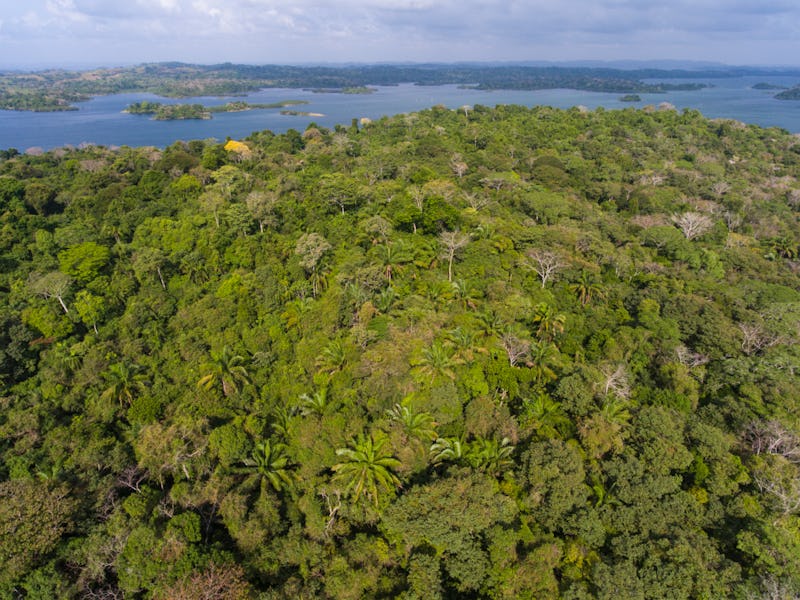Climate projections may have ignored the world’s secret weapon against climate change
Long live the tropical trees.

In Central America, a rich blend of lush, tropical trees are home to one of the world's most biodiverse communities. They provide a leafy haven for some of the planet's most incredible creatures, like jaguars and three-toed sloths.
And it turns out these trees play another vital, hidden role in preserving Earth's environment.
All trees play a part in combating global warming, breathing in carbon dioxide and storing it in the ground.
But when it comes to how effectively they carry out this environmental role, not all trees are created equal.
In a new study of Panama's tropical forests, researchers modeled forest demographics using a dataset spanning 40 years and nearly 300 tree species. They reveal that long-living, slow-growing, and massive trees make up most of the forest’s biomass. These so-called “long-lived pioneers” play a disproportionately large part in stashing carbon.
Protecting these trees is vital to the planet’s future, the researchers say.
Current climate-change forecasts tend to treat all trees equally, but this study suggests some should be taken into greater account than others, fundamentally altering the forecast models.
"This analysis shows that that is not good enough for tropical forests and provides a way forward," said study co-author Caroline Farrior, an assistant professor of integrative biology at The University of Texas, in a statement.
"We show that the variation in tropical forest species's growth, survival and reproduction is important for predicting forest carbon storage."
The forests of Panama are some of the most biodiverse in the world. They may also harbor trees vital to fighting climate change.
The research appeared Thursday in the journal Science.
Tracking trees over time — In the study, the researchers simulated how trees grow, die, reproduce, and compete for light in the Panama forest.
Species contrast in two big ways: height, and lifespan. These two traits translated into significant differences in carbon storage capacity.
Somewhat counterintuitively, trees that reach maturity quickly may not be best at taking up carbon, the models suggest.
Fast-growing trees, shrubs, and treelets require more sunlight to grow and reproduce quickly. But they also might die quickly, cutting short their potential benefits for the environment.
While smaller trees live fast and die young, long-lived pioneers stick around to grow big and strong. They maintain their climate benefits throughout their lengthy lifespans, reaching maturity later in their lives.
The drawback? These secret weapons against climate change are not the best at reproducing.
Instead of producing offspring, they spend their energy bulking up, the researchers suggest. That tradeoff pays out handsomely in the long run when it comes to carbon storage — but only if these trees are allowed to reach their full potential.
Tree lifespans are a tradeoff between quick and steady growth, data shows.
When tropical trees are cleared to make way for crops like oil palms and animal agriculture, long-term growth is cut short, too. As a result, we lose an outsized amount of carbon-storing biomass.
Old-growth forests have already taken a hit — Clear-cutting forests for lumber and agriculture has taken a toll on the Earth’s trees. Today, just half of the planet’s tropical forests contain undisturbed, old-growth trees.
And the other half? Those forests are in recovery mode, slowly regenerating after their stocks were used for timber or fuel. But the younger trees capture just a fraction of the carbon dioxide that long-lived trees soak up.
Protecting these developing forests is absolutely vital, but it may be more strategic to focus the world's conservation efforts on older trees, the authors of the new study say. Understanding tropical forests' complex dynamics in more fine-grained detail will help us manage their precious resources for the future.
Trunk and seedling of a long-lived pioneer (Cavanillesia platanifolia).
"Basically, we were able to reduce the forest to its essence, and that was only possible because we know so much about the tree species in the forest in Panama," Nadja Rüger, lead study author and a researcher at the German Center for Integrative Biodiversity Research, said in a statement.
The new models may help predict future climate change, as trees are both affected by climate change, and help to slow its pace. Right now, the Earth’s vegetation sops up about 34 percent of the carbon dioxide humans emit.
But when it comes to trees specifically, these incredible plants can’t keep up that work of slowing global warming without their massive, long-lived pioneers.
Abstract: Understanding tropical forest dynamics and planning for their sustainable management require efficient, yet accurate, predictions of the joint dynamics of hundreds of tree species. With increasing information on tropical tree life histories, our predictive understanding is no longer limited by species data but by the ability of existing models to make use of it. Using a demographic forest model, we show that the basal area and compositional changes during forest succession in a neotropical forest can be accurately predicted by representing tropical tree diversity (hundreds of species) with only five functional groups spanning two essential trade-offs—the growth-survival and stature-recruitment trade-offs. This data-driven modeling framework substantially improves our ability to predict consequences of anthropogenic impacts on tropical forests.